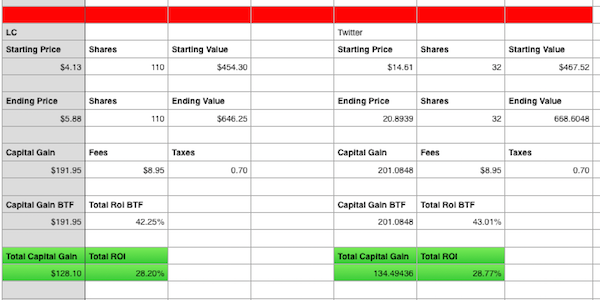Okay, so these aren’t actually my first two trades, but they’re the first I’ve made ever since I decided to get serious about stock market investing and allocating my funds.
My overall financial position looks as follows:
- Roth IRA
- Simple index fund
- Investment in my own businesses(s).
- Value Investing Portfolio (what I’m talking about with this post).
So for all of you financial experts out there, yes, dollar cost averaging the S&P 500 is the best way to allocate your funds via the stock market for the average investor. I’m trying to get better than average returns by applying value investing principles to stock selection.
I made the decision to buy TWTR (Twitter) and LC (Lending Club) when they started to receive negative press attention, which sent their stock plummeting.
The reason I decided to buy them was:
- I believed they were undervalued based on my own financial analysis and knowledge of the different sectors.
- I believed the market would correct itself over time.
I didn’t know when the market would look more favorably upon these stocks, but I had a strong feeling it would be within a year’s time, more likely 6-8 months.
I made the decision that I would sell as soon as the price equated a 20% ROI after taxes. I wouldn’t seek any more gains. If I wanted back into the stock, I’d have to re-purchase the stock.
This eliminated the anticipation or “hope” that the stock would go higher. It also prevented me from constantly checking the stock price. You can just use a tool like Zignals to be notified of price changes.
Also, I used the tool YCharts to analyze stock market charts and get price to book value or PE growth more easily.
The Excel Framework I Made
While the actual two trades each had an ROI of about 43%, the ROI after taxes and fees was only 28%, which is still good!
As you can see, I’m comparing these results to the S&P 500, which grew about 5-6% during the same time period. It’s very important that you use the S&P or a similar fund as a benchmark. Otherwise, you could be doing well and it’s just because of the overall market.
My Takeaways
It’s hard work to research companies and invest money in individual stocks. It’s very time consuming. My initial thought after making my first two trades was, “I need to invest much more money if this is going to be worthwhile.”
By investing more money, I’ll obviously increase the risk if I make the wrong decision, but I can afford to lose this money. It’s specifically why I’ve set up another fund that is separate from my main investing.
This decision panned out in a span of 3 months. I think my goal should be to make two correct investing decisions each year.
That will really help me to narrow my focus, attention, and cut out stocks that aren’t my top picks. It seems like you don’t have to get a lot of decisions right. You just have to get a few right in a large way.
The important thing is to not let emotions get involved. Each trade should go through the same standards, no matter how much money it is or which companies I’m investing in. Gotta follow the system!
Overall, these investments are designed to create a hedge against the risk of running my own business and continue to create a lifestyle that isn’t tied to time or location.


